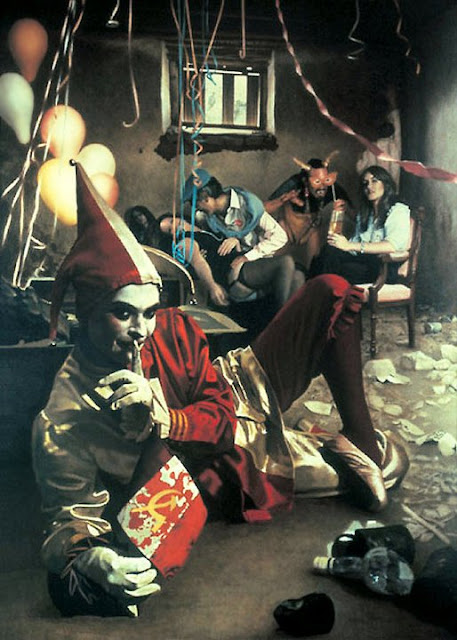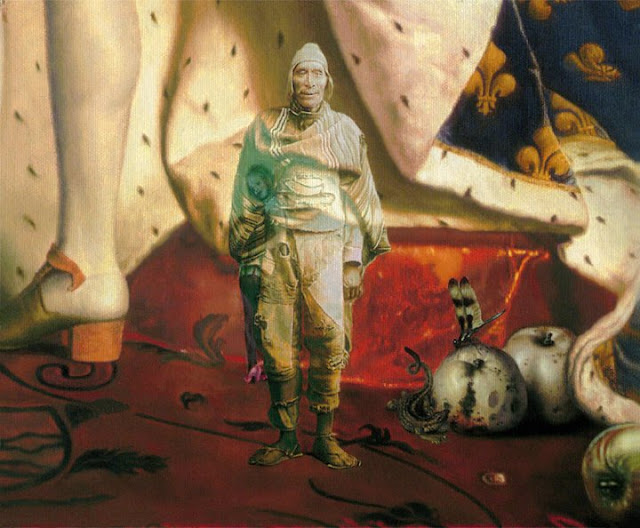"I am a figurative Peruvian painter; ARC Living Master. In 1973 entered the school of Fine Arts in Lima, with the highest grade, but a year later I decided to leave the school to start investigating on my own the art of the Old Masters. In 1981 I exhibited for the first time at an international level, representing Peru in the IV Biennial in Medellin, Colombia. In 1982 I represented Peru again in the Pan American Graphic Arts Program (AGPA) sponsored by Cartón y Papel de México, in Mexico City. In 1989 I won the painting prize for the celebration of the Bicentennial of the French Revolution, and in 1990 I traveled to France, invited as a professor at the 'École Nationale des Beaux-Arts' in Paris, where I lived most of the decade of the nineties.
At present I live and work in the countryside of Lima. In my latest works I have been experimenting with the possibilities of new technologies to compose my oil paintings."
Luis José Estremadoyro
Jose Estremadoyro was born in Peru in 1955.
In 1973 Luis Jose Estremadoyro entered the school of Fine Arts in his native city with the highest grade. A year later he decided to leave the school to start investigating on his own the art of the Old Masters. In 1981 he exhibited for the first time at an international level, representing Peru in the IV Biennial in Medellin, Colombia, where the critics recognized him among the most important Latin American figurative painters.
Excerpts:
Darío Ruiz Gómez. (IV Biennial in Medellin. Daily “El Tiempo”. Bogota, 05.15.81)
"...It is clear that old assumptions about what is 'Latin American' have been surpassed, and in most cases what counts is the personal search of one who, without denying an historical and cultural specificity, is creating a coherent pictorial response - be it figurative or conceptual - to the situation that one is living. Such is the case with the Peruvian figurative Estremadoyro, who, endeavoring to recover apparently obsolete techniques - the craft of oil painting in the XVII century, for example - maintains, thanks to the belligerency of this craft, an equilibrium against the chaos, the oppression, the acculturation disguised as false 'vanguard'.
Because to persevere in the task of symbolizing a space, referencing an object, does not lead in this case to a 'regression', as some naïvely think, but to a reflection about a particular language, to the recovery of a language that remains not as a dead heritage but as a lucid way to counteract the chaos and the violence of a senseless history..."
Daily “El Colombiano”. (Medellin, 05.18.81)
"Gregorio Cuartas. belongs to a style of figuration that in Latin America has excellent representatives such as the Chilean Claudio Bravo, the Argentinean Giuffré and the Peruvians Aquino and Luis José Estremadoyro..."
Teresa del Conde. (Visual Arts Director INBA, México D.F. – Exposition Catalog AGPA 82)
"...It would be tedious to comment on the technical and iconographic characteristics of each work, so I will limit myself to pointing out the ones that to my judgment are the most interesting. Attention is powerfully drawn to the aggregate that Peru presents. They are all practitioners of a naturalist figuration, whether in a symbological vein (Luis José Estremadoyro), or conceptually related to critical realism (Cervantes, Pestana), or inscribed in artistic paraphrasing (Braun)..."
Fietta Jarque. ( Daily “El Observador”. Lima, 08.18.83)
"...'The Rejoindure' is a work that during the night of the inauguration attracted the attention of all in attendance. This painting by Luis José Estremadoyro is a demential exacerbation of detail; it is not possible to distinguish a single brush stroke in this faithful reproduction of a still life in the Dutch style. The composition, the quality of the light and the technique, without mentioning of course the theme, could situate it anywhere in Europe in the last three centuries..."
Daily “La República”. (Lima, 08.30.85)
“…In spite of the youth Estremadoyro has participated in important events, in nationals as well internationals…”
Miguel Cruchaga Belaúnde. (Letter to Mario Vargas Llosa. 06.25.85)
"... Luis José Estremadoyro is one of the most outstanding exponents of a new generation of figurative painters. His painting produces such an extreme sense of reality that it incites to perplexity. . From the first time that I was invited to visit his studio I was overwhelmed by the fount of passion that Estremadoyro is . swayed by that faith I have come and gone to his aerie..."
Luis E. Lama (“Caretas” magazine. Lima, 08.05.85)
"...Luis José Estremadoyro presents a singular proposition in the form of a painting with truly exceptional connotations... The exhibit entitled 'Don't Tell Anyone' is a show that must be seen..."
María Elena Cornejo. (“Caretas” magazine. Lima, 12.04.89)
"Luis José Estremadoyro lives in a sort of Victorian castle located right in the heart of San Isidro. He views modern art from a distance, moreover, he is not interested in it. He believes profoundly in a realist aesthetic and in the living presence of the painting. His pictorial production however is not prolific. Each painting takes him months of labor, research and reflection. He is an artist who plays with time, colors, shapes, and with the characters in order to discover in them new modes of perception and communication..."
Alonso Ruiz Rosas. (Special for the Daily “El Comercio”. Paris, 10.23.97)
PARIS - "The Peruvian painter Luis José Estremadoyro inaugurated in recent days an exhibition of painting that is in a class by itself. an imposing figurative canvas of 2 by 3 meters that strives to be an allegory of the crisis in modern art..."
Phillipe Dagen. (Daily “Le Monde”. Paris, 01.03.97)
“Luis José Estremadoyro has lived several years in France. This Peruvian artist of extremely unusual paintings has on display a remarkable work, only one, but it is out of the ordinary and fiercely up to date. Its name is "The Eve" (La Víspera), and it is nothing less than a depiction of our times, saturated with horrors, and of our memory, saturated with references. There is immense ambition: To restore the great classic peinture d'histoire, and to delve deeply into the theme. To achieve this, Estremadoyro uses simultaneously the realistic pictorial style of effective illusionistic techniques, and pseudo-collages that let him insert fragments of illustrious works: Leonardo, Vermeer, Velázquez. This is how the mental confusion is suggested, the spiritual disorder, and a sort of observant hallucination that captivates you. There are abundant symbols of suffering and oppression, as well as many allusions to contemporary history."
source
(detail)







